Business Strategy Analysis Report: British Telecommunications (BT)
VerifiedAdded on 2022/11/24
|17
|5369
|327
Report
AI Summary
This report provides a comprehensive analysis of British Telecommunications' (BT) business strategy. It begins with an introduction to the company and its global presence. The main body includes an analysis of the macro-environment using the PESTLE framework, examining political, economic, social, technological, legal, and environmental factors impacting BT. A stakeholder analysis is also provided. The report then delves into the internal environment, employing VRIO analysis to assess BT's valuable, rare, inimitable, and organized resources. A SWOT analysis identifies BT's strengths, weaknesses, opportunities, and threats. Furthermore, the report applies Porter's Five Forces model to evaluate the competitive landscape and suggests strategies to enhance BT's competitive edge. Finally, it outlines strategic planning recommendations, incorporating tactical and tangible strategic objectives.
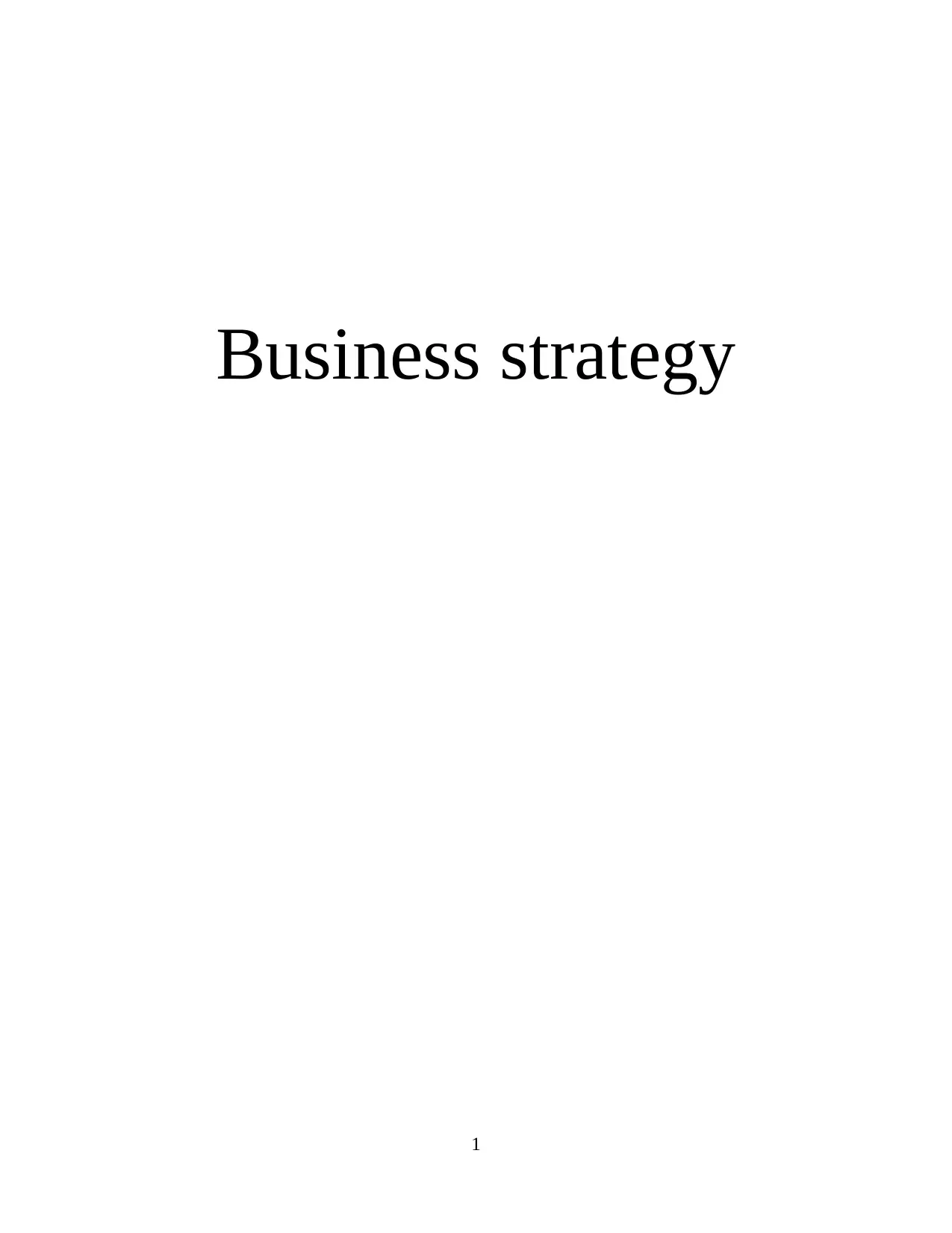
Business strategy
1
1
Paraphrase This Document
Need a fresh take? Get an instant paraphrase of this document with our AI Paraphraser
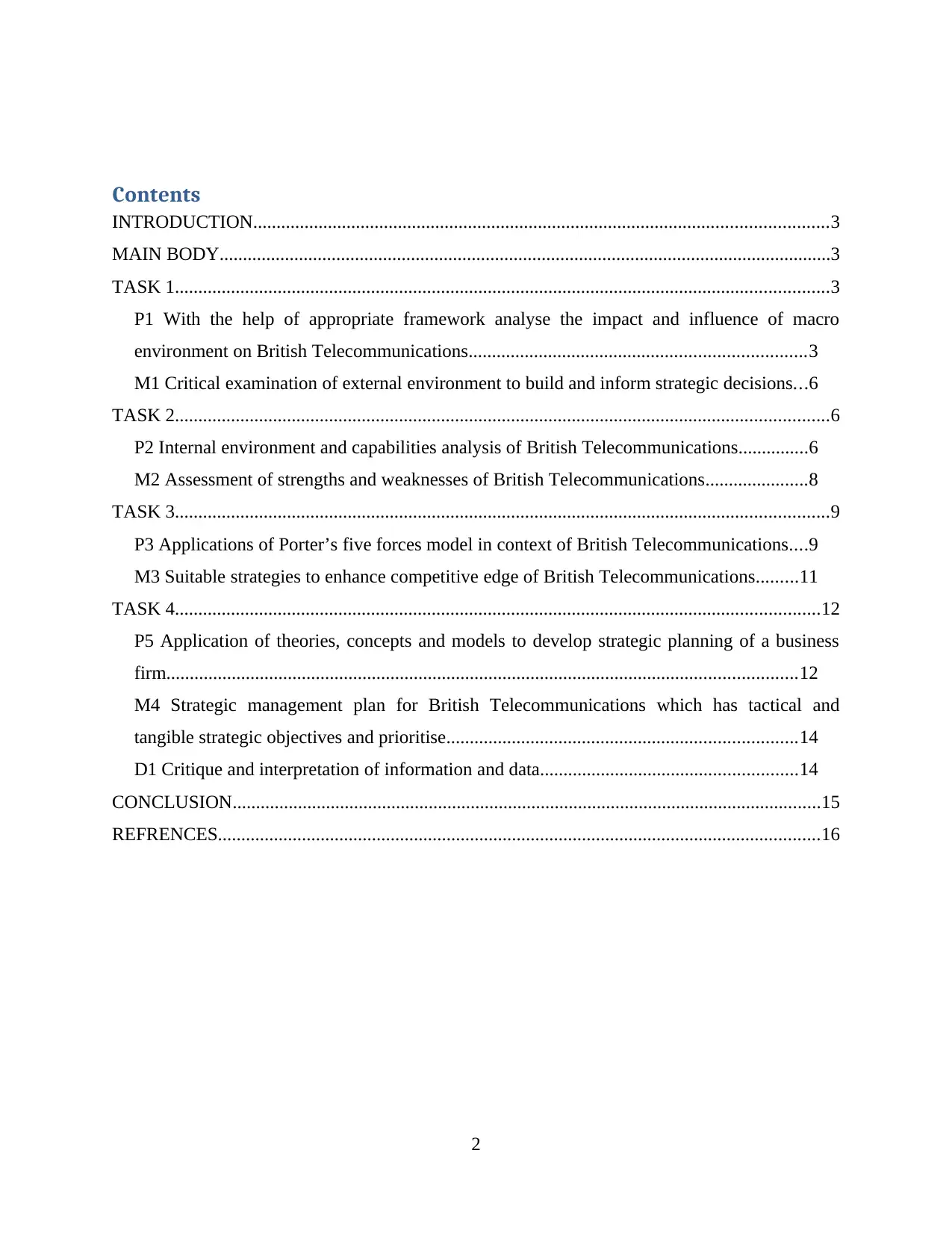
Contents
INTRODUCTION...........................................................................................................................3
MAIN BODY...................................................................................................................................3
TASK 1............................................................................................................................................3
P1 With the help of appropriate framework analyse the impact and influence of macro
environment on British Telecommunications........................................................................3
M1 Critical examination of external environment to build and inform strategic decisions...6
TASK 2............................................................................................................................................6
P2 Internal environment and capabilities analysis of British Telecommunications...............6
M2 Assessment of strengths and weaknesses of British Telecommunications......................8
TASK 3............................................................................................................................................9
P3 Applications of Porter’s five forces model in context of British Telecommunications....9
M3 Suitable strategies to enhance competitive edge of British Telecommunications.........11
TASK 4..........................................................................................................................................12
P5 Application of theories, concepts and models to develop strategic planning of a business
firm.......................................................................................................................................12
M4 Strategic management plan for British Telecommunications which has tactical and
tangible strategic objectives and prioritise...........................................................................14
D1 Critique and interpretation of information and data.......................................................14
CONCLUSION..............................................................................................................................15
REFRENCES.................................................................................................................................16
2
INTRODUCTION...........................................................................................................................3
MAIN BODY...................................................................................................................................3
TASK 1............................................................................................................................................3
P1 With the help of appropriate framework analyse the impact and influence of macro
environment on British Telecommunications........................................................................3
M1 Critical examination of external environment to build and inform strategic decisions...6
TASK 2............................................................................................................................................6
P2 Internal environment and capabilities analysis of British Telecommunications...............6
M2 Assessment of strengths and weaknesses of British Telecommunications......................8
TASK 3............................................................................................................................................9
P3 Applications of Porter’s five forces model in context of British Telecommunications....9
M3 Suitable strategies to enhance competitive edge of British Telecommunications.........11
TASK 4..........................................................................................................................................12
P5 Application of theories, concepts and models to develop strategic planning of a business
firm.......................................................................................................................................12
M4 Strategic management plan for British Telecommunications which has tactical and
tangible strategic objectives and prioritise...........................................................................14
D1 Critique and interpretation of information and data.......................................................14
CONCLUSION..............................................................................................................................15
REFRENCES.................................................................................................................................16
2
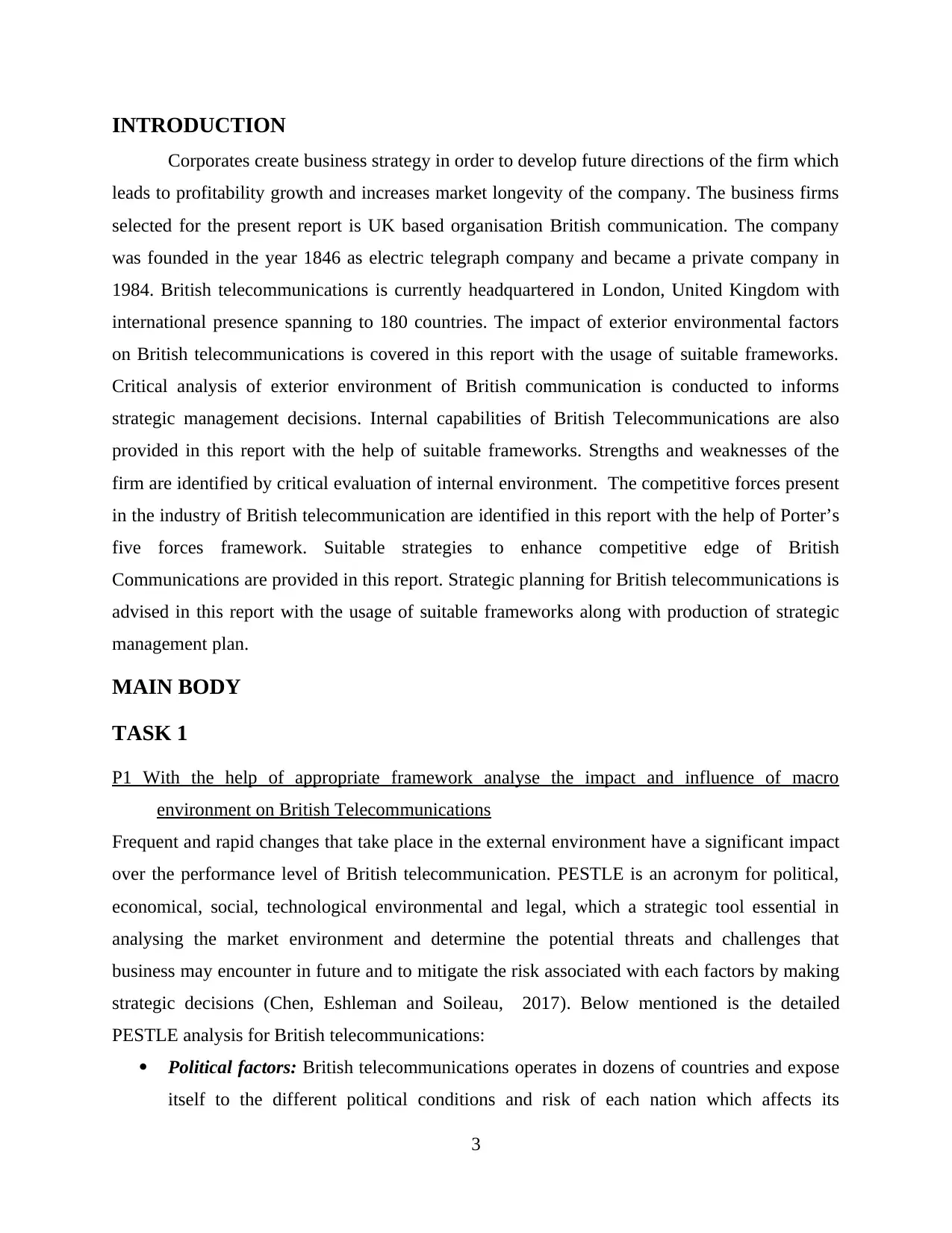
INTRODUCTION
Corporates create business strategy in order to develop future directions of the firm which
leads to profitability growth and increases market longevity of the company. The business firms
selected for the present report is UK based organisation British communication. The company
was founded in the year 1846 as electric telegraph company and became a private company in
1984. British telecommunications is currently headquartered in London, United Kingdom with
international presence spanning to 180 countries. The impact of exterior environmental factors
on British telecommunications is covered in this report with the usage of suitable frameworks.
Critical analysis of exterior environment of British communication is conducted to informs
strategic management decisions. Internal capabilities of British Telecommunications are also
provided in this report with the help of suitable frameworks. Strengths and weaknesses of the
firm are identified by critical evaluation of internal environment. The competitive forces present
in the industry of British telecommunication are identified in this report with the help of Porter’s
five forces framework. Suitable strategies to enhance competitive edge of British
Communications are provided in this report. Strategic planning for British telecommunications is
advised in this report with the usage of suitable frameworks along with production of strategic
management plan.
MAIN BODY
TASK 1
P1 With the help of appropriate framework analyse the impact and influence of macro
environment on British Telecommunications
Frequent and rapid changes that take place in the external environment have a significant impact
over the performance level of British telecommunication. PESTLE is an acronym for political,
economical, social, technological environmental and legal, which a strategic tool essential in
analysing the market environment and determine the potential threats and challenges that
business may encounter in future and to mitigate the risk associated with each factors by making
strategic decisions (Chen, Eshleman and Soileau, 2017). Below mentioned is the detailed
PESTLE analysis for British telecommunications:
Political factors: British telecommunications operates in dozens of countries and expose
itself to the different political conditions and risk of each nation which affects its
3
Corporates create business strategy in order to develop future directions of the firm which
leads to profitability growth and increases market longevity of the company. The business firms
selected for the present report is UK based organisation British communication. The company
was founded in the year 1846 as electric telegraph company and became a private company in
1984. British telecommunications is currently headquartered in London, United Kingdom with
international presence spanning to 180 countries. The impact of exterior environmental factors
on British telecommunications is covered in this report with the usage of suitable frameworks.
Critical analysis of exterior environment of British communication is conducted to informs
strategic management decisions. Internal capabilities of British Telecommunications are also
provided in this report with the help of suitable frameworks. Strengths and weaknesses of the
firm are identified by critical evaluation of internal environment. The competitive forces present
in the industry of British telecommunication are identified in this report with the help of Porter’s
five forces framework. Suitable strategies to enhance competitive edge of British
Communications are provided in this report. Strategic planning for British telecommunications is
advised in this report with the usage of suitable frameworks along with production of strategic
management plan.
MAIN BODY
TASK 1
P1 With the help of appropriate framework analyse the impact and influence of macro
environment on British Telecommunications
Frequent and rapid changes that take place in the external environment have a significant impact
over the performance level of British telecommunication. PESTLE is an acronym for political,
economical, social, technological environmental and legal, which a strategic tool essential in
analysing the market environment and determine the potential threats and challenges that
business may encounter in future and to mitigate the risk associated with each factors by making
strategic decisions (Chen, Eshleman and Soileau, 2017). Below mentioned is the detailed
PESTLE analysis for British telecommunications:
Political factors: British telecommunications operates in dozens of countries and expose
itself to the different political conditions and risk of each nation which affects its
3
⊘ This is a preview!⊘
Do you want full access?
Subscribe today to unlock all pages.

Trusted by 1+ million students worldwide
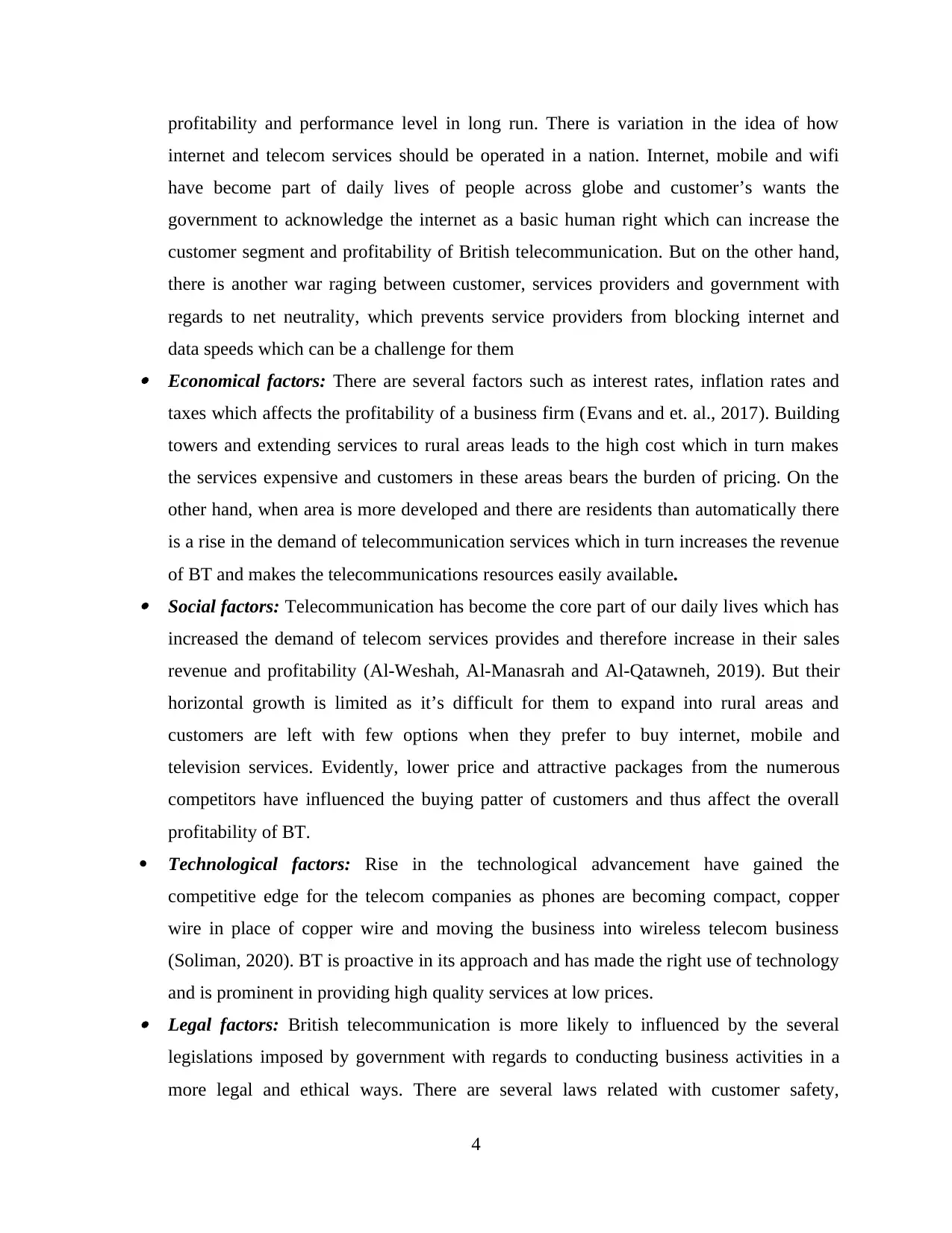
profitability and performance level in long run. There is variation in the idea of how
internet and telecom services should be operated in a nation. Internet, mobile and wifi
have become part of daily lives of people across globe and customer’s wants the
government to acknowledge the internet as a basic human right which can increase the
customer segment and profitability of British telecommunication. But on the other hand,
there is another war raging between customer, services providers and government with
regards to net neutrality, which prevents service providers from blocking internet and
data speeds which can be a challenge for them Economical factors: There are several factors such as interest rates, inflation rates and
taxes which affects the profitability of a business firm (Evans and et. al., 2017). Building
towers and extending services to rural areas leads to the high cost which in turn makes
the services expensive and customers in these areas bears the burden of pricing. On the
other hand, when area is more developed and there are residents than automatically there
is a rise in the demand of telecommunication services which in turn increases the revenue
of BT and makes the telecommunications resources easily available. Social factors: Telecommunication has become the core part of our daily lives which has
increased the demand of telecom services provides and therefore increase in their sales
revenue and profitability (Al-Weshah, Al-Manasrah and Al-Qatawneh, 2019). But their
horizontal growth is limited as it’s difficult for them to expand into rural areas and
customers are left with few options when they prefer to buy internet, mobile and
television services. Evidently, lower price and attractive packages from the numerous
competitors have influenced the buying patter of customers and thus affect the overall
profitability of BT.
Technological factors: Rise in the technological advancement have gained the
competitive edge for the telecom companies as phones are becoming compact, copper
wire in place of copper wire and moving the business into wireless telecom business
(Soliman, 2020). BT is proactive in its approach and has made the right use of technology
and is prominent in providing high quality services at low prices. Legal factors: British telecommunication is more likely to influenced by the several
legislations imposed by government with regards to conducting business activities in a
more legal and ethical ways. There are several laws related with customer safety,
4
internet and telecom services should be operated in a nation. Internet, mobile and wifi
have become part of daily lives of people across globe and customer’s wants the
government to acknowledge the internet as a basic human right which can increase the
customer segment and profitability of British telecommunication. But on the other hand,
there is another war raging between customer, services providers and government with
regards to net neutrality, which prevents service providers from blocking internet and
data speeds which can be a challenge for them Economical factors: There are several factors such as interest rates, inflation rates and
taxes which affects the profitability of a business firm (Evans and et. al., 2017). Building
towers and extending services to rural areas leads to the high cost which in turn makes
the services expensive and customers in these areas bears the burden of pricing. On the
other hand, when area is more developed and there are residents than automatically there
is a rise in the demand of telecommunication services which in turn increases the revenue
of BT and makes the telecommunications resources easily available. Social factors: Telecommunication has become the core part of our daily lives which has
increased the demand of telecom services provides and therefore increase in their sales
revenue and profitability (Al-Weshah, Al-Manasrah and Al-Qatawneh, 2019). But their
horizontal growth is limited as it’s difficult for them to expand into rural areas and
customers are left with few options when they prefer to buy internet, mobile and
television services. Evidently, lower price and attractive packages from the numerous
competitors have influenced the buying patter of customers and thus affect the overall
profitability of BT.
Technological factors: Rise in the technological advancement have gained the
competitive edge for the telecom companies as phones are becoming compact, copper
wire in place of copper wire and moving the business into wireless telecom business
(Soliman, 2020). BT is proactive in its approach and has made the right use of technology
and is prominent in providing high quality services at low prices. Legal factors: British telecommunication is more likely to influenced by the several
legislations imposed by government with regards to conducting business activities in a
more legal and ethical ways. There are several laws related with customer safety,
4
Paraphrase This Document
Need a fresh take? Get an instant paraphrase of this document with our AI Paraphraser

protection of confidential information and laws pertaining to the maintaining desired
standards and laws related with the dominance over market which affect the profitability
of BT in long run. Environmental factors: Climate changes and global warming is affecting the way
telecom companies are operating in a market and delivering their services (Valinejad and
Rahmani, 2018). For instance, mobile towers generates high ultra violet rays which is
dangerous to the infant babies and people living in nearby areas which may affect their
connectivity as they may need to transfer the tower from highly populated area to a more
isolated place.
Stakeholder’s analysis
LEVEL OF INTEREST
LEVEL OF
POWER
HIGH LOW
HIGH Shareholders, Workforce Government
LOW Consumers Suppliers
Shareholders: The shareholders of the British Telecommunications have high power and
high interest on the daily business operations of the firm. The stakeholder’s which have high
power and high interest are the most significant stakeholder’s of the company (González-
Rodrígue and et. al., 2018). British Telecommunications need to ensure that the stakeholder’s
with high interest gain desired results from the company.
Workforce: The workforce of the company is a vital stakeholder’s and has high power as
the workforce participates in decision making process and is essential for completion of daily
business operations of the firm. The workforce also has high interest in the firm because the
company provides remuneration and growth opportunity to employees. British
Telecommunications need to consider the impact of their strategy on the workforce.
Government: The stakeholders which have high power and low interest on the firm need
to be satisfied but it is not essential to communicate with these stakeholders as they have lack of
interest in daily business activities (Grayson and Hodges, 2017). In case of British
Telecommunications, government authorities are included in the category of high power, low
interests stakeholders. This is because the government can influence business decisions of the
5
standards and laws related with the dominance over market which affect the profitability
of BT in long run. Environmental factors: Climate changes and global warming is affecting the way
telecom companies are operating in a market and delivering their services (Valinejad and
Rahmani, 2018). For instance, mobile towers generates high ultra violet rays which is
dangerous to the infant babies and people living in nearby areas which may affect their
connectivity as they may need to transfer the tower from highly populated area to a more
isolated place.
Stakeholder’s analysis
LEVEL OF INTEREST
LEVEL OF
POWER
HIGH LOW
HIGH Shareholders, Workforce Government
LOW Consumers Suppliers
Shareholders: The shareholders of the British Telecommunications have high power and
high interest on the daily business operations of the firm. The stakeholder’s which have high
power and high interest are the most significant stakeholder’s of the company (González-
Rodrígue and et. al., 2018). British Telecommunications need to ensure that the stakeholder’s
with high interest gain desired results from the company.
Workforce: The workforce of the company is a vital stakeholder’s and has high power as
the workforce participates in decision making process and is essential for completion of daily
business operations of the firm. The workforce also has high interest in the firm because the
company provides remuneration and growth opportunity to employees. British
Telecommunications need to consider the impact of their strategy on the workforce.
Government: The stakeholders which have high power and low interest on the firm need
to be satisfied but it is not essential to communicate with these stakeholders as they have lack of
interest in daily business activities (Grayson and Hodges, 2017). In case of British
Telecommunications, government authorities are included in the category of high power, low
interests stakeholders. This is because the government can influence business decisions of the
5
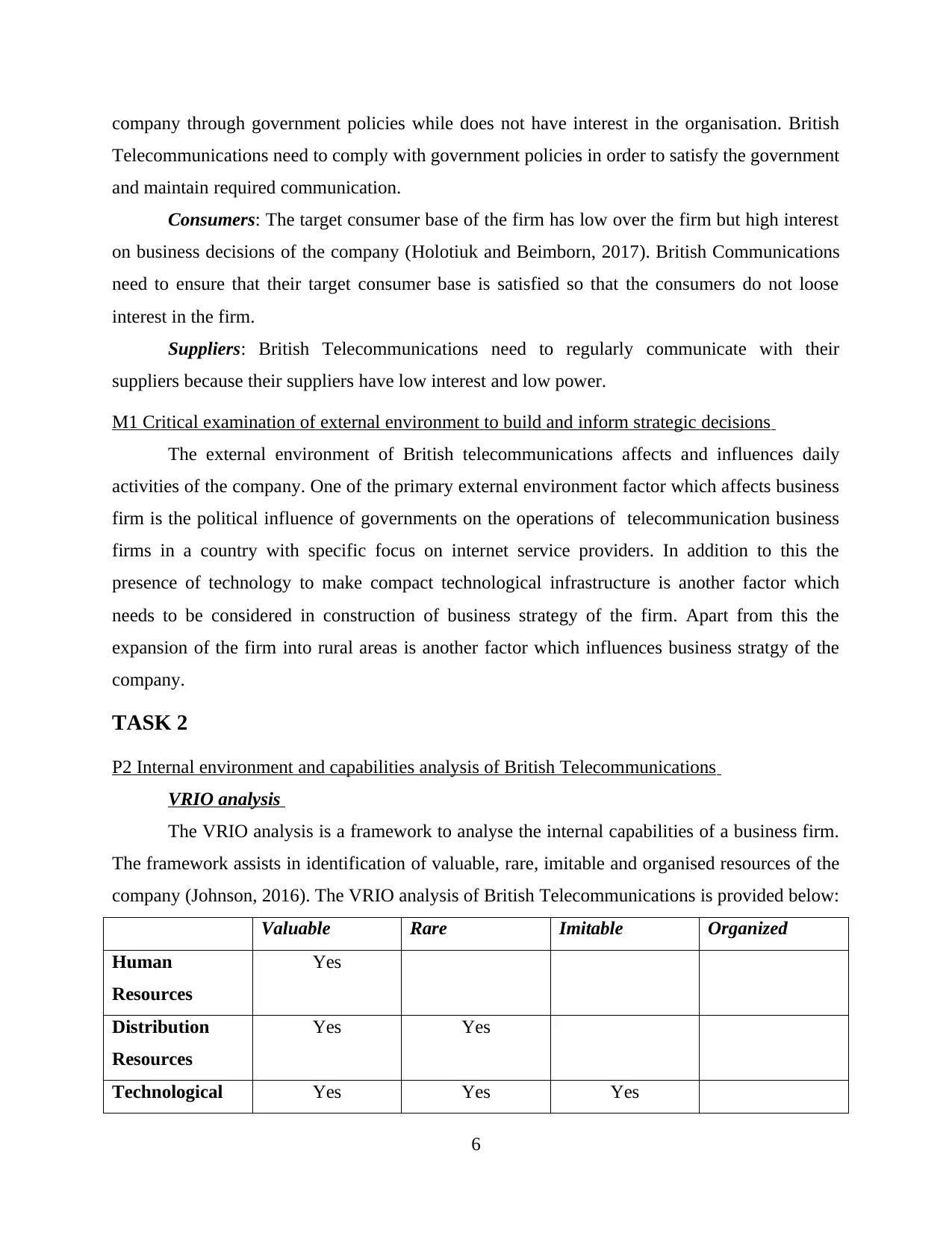
company through government policies while does not have interest in the organisation. British
Telecommunications need to comply with government policies in order to satisfy the government
and maintain required communication.
Consumers: The target consumer base of the firm has low over the firm but high interest
on business decisions of the company (Holotiuk and Beimborn, 2017). British Communications
need to ensure that their target consumer base is satisfied so that the consumers do not loose
interest in the firm.
Suppliers: British Telecommunications need to regularly communicate with their
suppliers because their suppliers have low interest and low power.
M1 Critical examination of external environment to build and inform strategic decisions
The external environment of British telecommunications affects and influences daily
activities of the company. One of the primary external environment factor which affects business
firm is the political influence of governments on the operations of telecommunication business
firms in a country with specific focus on internet service providers. In addition to this the
presence of technology to make compact technological infrastructure is another factor which
needs to be considered in construction of business strategy of the firm. Apart from this the
expansion of the firm into rural areas is another factor which influences business stratgy of the
company.
TASK 2
P2 Internal environment and capabilities analysis of British Telecommunications
VRIO analysis
The VRIO analysis is a framework to analyse the internal capabilities of a business firm.
The framework assists in identification of valuable, rare, imitable and organised resources of the
company (Johnson, 2016). The VRIO analysis of British Telecommunications is provided below:
Valuable Rare Imitable Organized
Human
Resources
Yes
Distribution
Resources
Yes Yes
Technological Yes Yes Yes
6
Telecommunications need to comply with government policies in order to satisfy the government
and maintain required communication.
Consumers: The target consumer base of the firm has low over the firm but high interest
on business decisions of the company (Holotiuk and Beimborn, 2017). British Communications
need to ensure that their target consumer base is satisfied so that the consumers do not loose
interest in the firm.
Suppliers: British Telecommunications need to regularly communicate with their
suppliers because their suppliers have low interest and low power.
M1 Critical examination of external environment to build and inform strategic decisions
The external environment of British telecommunications affects and influences daily
activities of the company. One of the primary external environment factor which affects business
firm is the political influence of governments on the operations of telecommunication business
firms in a country with specific focus on internet service providers. In addition to this the
presence of technology to make compact technological infrastructure is another factor which
needs to be considered in construction of business strategy of the firm. Apart from this the
expansion of the firm into rural areas is another factor which influences business stratgy of the
company.
TASK 2
P2 Internal environment and capabilities analysis of British Telecommunications
VRIO analysis
The VRIO analysis is a framework to analyse the internal capabilities of a business firm.
The framework assists in identification of valuable, rare, imitable and organised resources of the
company (Johnson, 2016). The VRIO analysis of British Telecommunications is provided below:
Valuable Rare Imitable Organized
Human
Resources
Yes
Distribution
Resources
Yes Yes
Technological Yes Yes Yes
6
⊘ This is a preview!⊘
Do you want full access?
Subscribe today to unlock all pages.

Trusted by 1+ million students worldwide
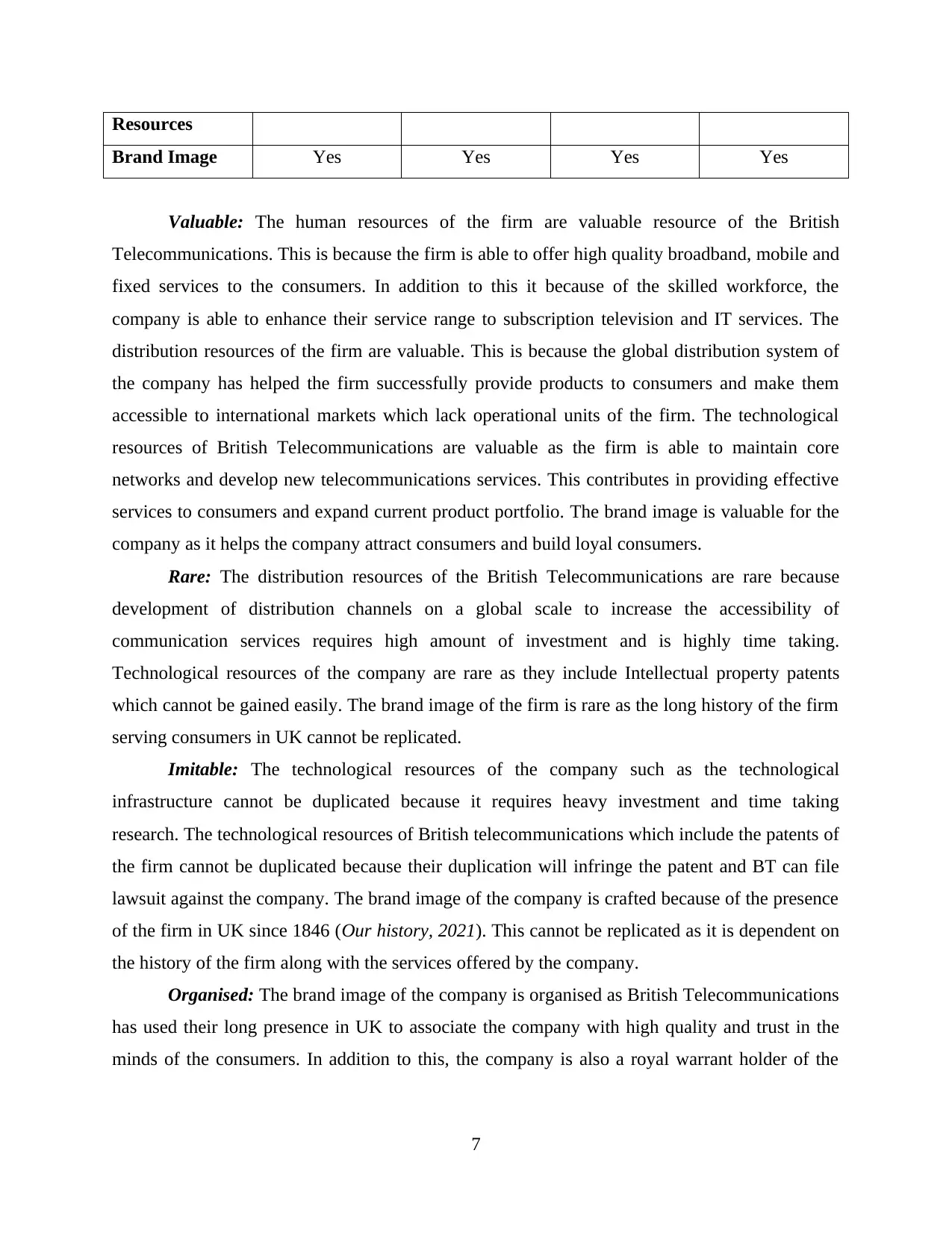
Resources
Brand Image Yes Yes Yes Yes
Valuable: The human resources of the firm are valuable resource of the British
Telecommunications. This is because the firm is able to offer high quality broadband, mobile and
fixed services to the consumers. In addition to this it because of the skilled workforce, the
company is able to enhance their service range to subscription television and IT services. The
distribution resources of the firm are valuable. This is because the global distribution system of
the company has helped the firm successfully provide products to consumers and make them
accessible to international markets which lack operational units of the firm. The technological
resources of British Telecommunications are valuable as the firm is able to maintain core
networks and develop new telecommunications services. This contributes in providing effective
services to consumers and expand current product portfolio. The brand image is valuable for the
company as it helps the company attract consumers and build loyal consumers.
Rare: The distribution resources of the British Telecommunications are rare because
development of distribution channels on a global scale to increase the accessibility of
communication services requires high amount of investment and is highly time taking.
Technological resources of the company are rare as they include Intellectual property patents
which cannot be gained easily. The brand image of the firm is rare as the long history of the firm
serving consumers in UK cannot be replicated.
Imitable: The technological resources of the company such as the technological
infrastructure cannot be duplicated because it requires heavy investment and time taking
research. The technological resources of British telecommunications which include the patents of
the firm cannot be duplicated because their duplication will infringe the patent and BT can file
lawsuit against the company. The brand image of the company is crafted because of the presence
of the firm in UK since 1846 (Our history, 2021). This cannot be replicated as it is dependent on
the history of the firm along with the services offered by the company.
Organised: The brand image of the company is organised as British Telecommunications
has used their long presence in UK to associate the company with high quality and trust in the
minds of the consumers. In addition to this, the company is also a royal warrant holder of the
7
Brand Image Yes Yes Yes Yes
Valuable: The human resources of the firm are valuable resource of the British
Telecommunications. This is because the firm is able to offer high quality broadband, mobile and
fixed services to the consumers. In addition to this it because of the skilled workforce, the
company is able to enhance their service range to subscription television and IT services. The
distribution resources of the firm are valuable. This is because the global distribution system of
the company has helped the firm successfully provide products to consumers and make them
accessible to international markets which lack operational units of the firm. The technological
resources of British Telecommunications are valuable as the firm is able to maintain core
networks and develop new telecommunications services. This contributes in providing effective
services to consumers and expand current product portfolio. The brand image is valuable for the
company as it helps the company attract consumers and build loyal consumers.
Rare: The distribution resources of the British Telecommunications are rare because
development of distribution channels on a global scale to increase the accessibility of
communication services requires high amount of investment and is highly time taking.
Technological resources of the company are rare as they include Intellectual property patents
which cannot be gained easily. The brand image of the firm is rare as the long history of the firm
serving consumers in UK cannot be replicated.
Imitable: The technological resources of the company such as the technological
infrastructure cannot be duplicated because it requires heavy investment and time taking
research. The technological resources of British telecommunications which include the patents of
the firm cannot be duplicated because their duplication will infringe the patent and BT can file
lawsuit against the company. The brand image of the company is crafted because of the presence
of the firm in UK since 1846 (Our history, 2021). This cannot be replicated as it is dependent on
the history of the firm along with the services offered by the company.
Organised: The brand image of the company is organised as British Telecommunications
has used their long presence in UK to associate the company with high quality and trust in the
minds of the consumers. In addition to this, the company is also a royal warrant holder of the
7
Paraphrase This Document
Need a fresh take? Get an instant paraphrase of this document with our AI Paraphraser
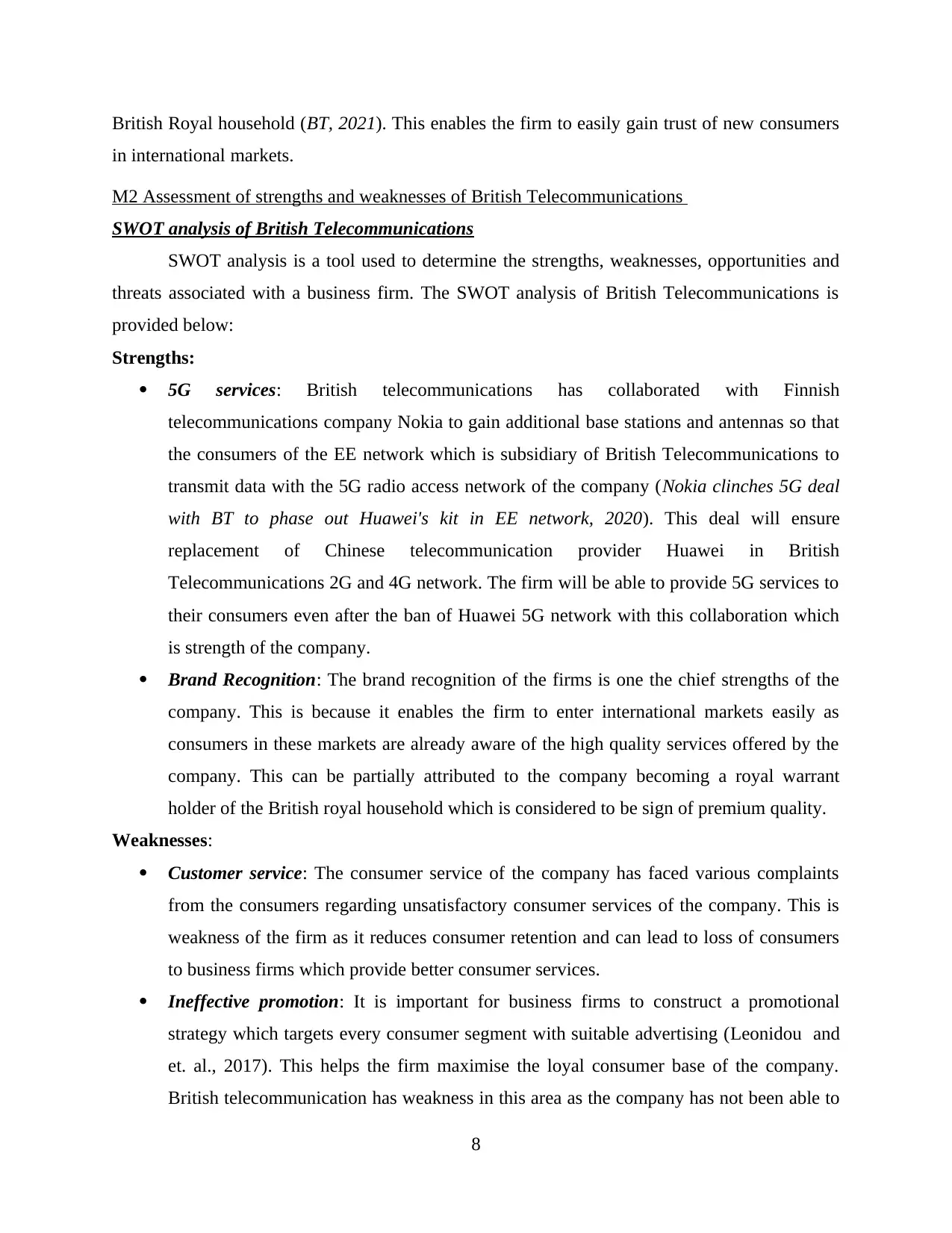
British Royal household (BT, 2021). This enables the firm to easily gain trust of new consumers
in international markets.
M2 Assessment of strengths and weaknesses of British Telecommunications
SWOT analysis of British Telecommunications
SWOT analysis is a tool used to determine the strengths, weaknesses, opportunities and
threats associated with a business firm. The SWOT analysis of British Telecommunications is
provided below:
Strengths:
5G services: British telecommunications has collaborated with Finnish
telecommunications company Nokia to gain additional base stations and antennas so that
the consumers of the EE network which is subsidiary of British Telecommunications to
transmit data with the 5G radio access network of the company (Nokia clinches 5G deal
with BT to phase out Huawei's kit in EE network, 2020). This deal will ensure
replacement of Chinese telecommunication provider Huawei in British
Telecommunications 2G and 4G network. The firm will be able to provide 5G services to
their consumers even after the ban of Huawei 5G network with this collaboration which
is strength of the company.
Brand Recognition: The brand recognition of the firms is one the chief strengths of the
company. This is because it enables the firm to enter international markets easily as
consumers in these markets are already aware of the high quality services offered by the
company. This can be partially attributed to the company becoming a royal warrant
holder of the British royal household which is considered to be sign of premium quality.
Weaknesses:
Customer service: The consumer service of the company has faced various complaints
from the consumers regarding unsatisfactory consumer services of the company. This is
weakness of the firm as it reduces consumer retention and can lead to loss of consumers
to business firms which provide better consumer services.
Ineffective promotion: It is important for business firms to construct a promotional
strategy which targets every consumer segment with suitable advertising (Leonidou and
et. al., 2017). This helps the firm maximise the loyal consumer base of the company.
British telecommunication has weakness in this area as the company has not been able to
8
in international markets.
M2 Assessment of strengths and weaknesses of British Telecommunications
SWOT analysis of British Telecommunications
SWOT analysis is a tool used to determine the strengths, weaknesses, opportunities and
threats associated with a business firm. The SWOT analysis of British Telecommunications is
provided below:
Strengths:
5G services: British telecommunications has collaborated with Finnish
telecommunications company Nokia to gain additional base stations and antennas so that
the consumers of the EE network which is subsidiary of British Telecommunications to
transmit data with the 5G radio access network of the company (Nokia clinches 5G deal
with BT to phase out Huawei's kit in EE network, 2020). This deal will ensure
replacement of Chinese telecommunication provider Huawei in British
Telecommunications 2G and 4G network. The firm will be able to provide 5G services to
their consumers even after the ban of Huawei 5G network with this collaboration which
is strength of the company.
Brand Recognition: The brand recognition of the firms is one the chief strengths of the
company. This is because it enables the firm to enter international markets easily as
consumers in these markets are already aware of the high quality services offered by the
company. This can be partially attributed to the company becoming a royal warrant
holder of the British royal household which is considered to be sign of premium quality.
Weaknesses:
Customer service: The consumer service of the company has faced various complaints
from the consumers regarding unsatisfactory consumer services of the company. This is
weakness of the firm as it reduces consumer retention and can lead to loss of consumers
to business firms which provide better consumer services.
Ineffective promotion: It is important for business firms to construct a promotional
strategy which targets every consumer segment with suitable advertising (Leonidou and
et. al., 2017). This helps the firm maximise the loyal consumer base of the company.
British telecommunication has weakness in this area as the company has not been able to
8
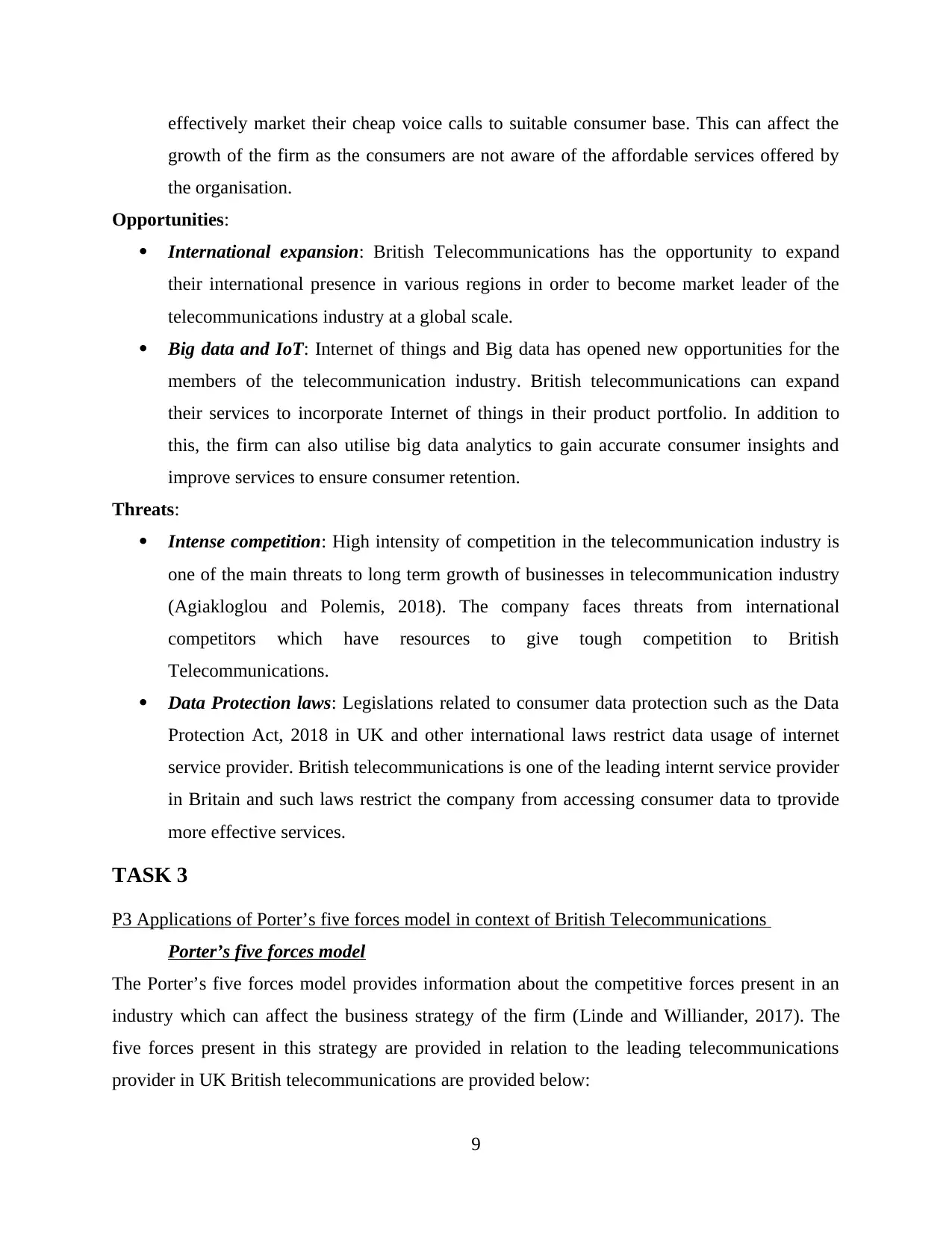
effectively market their cheap voice calls to suitable consumer base. This can affect the
growth of the firm as the consumers are not aware of the affordable services offered by
the organisation.
Opportunities:
International expansion: British Telecommunications has the opportunity to expand
their international presence in various regions in order to become market leader of the
telecommunications industry at a global scale.
Big data and IoT: Internet of things and Big data has opened new opportunities for the
members of the telecommunication industry. British telecommunications can expand
their services to incorporate Internet of things in their product portfolio. In addition to
this, the firm can also utilise big data analytics to gain accurate consumer insights and
improve services to ensure consumer retention.
Threats:
Intense competition: High intensity of competition in the telecommunication industry is
one of the main threats to long term growth of businesses in telecommunication industry
(Agiakloglou and Polemis, 2018). The company faces threats from international
competitors which have resources to give tough competition to British
Telecommunications.
Data Protection laws: Legislations related to consumer data protection such as the Data
Protection Act, 2018 in UK and other international laws restrict data usage of internet
service provider. British telecommunications is one of the leading internt service provider
in Britain and such laws restrict the company from accessing consumer data to tprovide
more effective services.
TASK 3
P3 Applications of Porter’s five forces model in context of British Telecommunications
Porter’s five forces model
The Porter’s five forces model provides information about the competitive forces present in an
industry which can affect the business strategy of the firm (Linde and Williander, 2017). The
five forces present in this strategy are provided in relation to the leading telecommunications
provider in UK British telecommunications are provided below:
9
growth of the firm as the consumers are not aware of the affordable services offered by
the organisation.
Opportunities:
International expansion: British Telecommunications has the opportunity to expand
their international presence in various regions in order to become market leader of the
telecommunications industry at a global scale.
Big data and IoT: Internet of things and Big data has opened new opportunities for the
members of the telecommunication industry. British telecommunications can expand
their services to incorporate Internet of things in their product portfolio. In addition to
this, the firm can also utilise big data analytics to gain accurate consumer insights and
improve services to ensure consumer retention.
Threats:
Intense competition: High intensity of competition in the telecommunication industry is
one of the main threats to long term growth of businesses in telecommunication industry
(Agiakloglou and Polemis, 2018). The company faces threats from international
competitors which have resources to give tough competition to British
Telecommunications.
Data Protection laws: Legislations related to consumer data protection such as the Data
Protection Act, 2018 in UK and other international laws restrict data usage of internet
service provider. British telecommunications is one of the leading internt service provider
in Britain and such laws restrict the company from accessing consumer data to tprovide
more effective services.
TASK 3
P3 Applications of Porter’s five forces model in context of British Telecommunications
Porter’s five forces model
The Porter’s five forces model provides information about the competitive forces present in an
industry which can affect the business strategy of the firm (Linde and Williander, 2017). The
five forces present in this strategy are provided in relation to the leading telecommunications
provider in UK British telecommunications are provided below:
9
⊘ This is a preview!⊘
Do you want full access?
Subscribe today to unlock all pages.

Trusted by 1+ million students worldwide
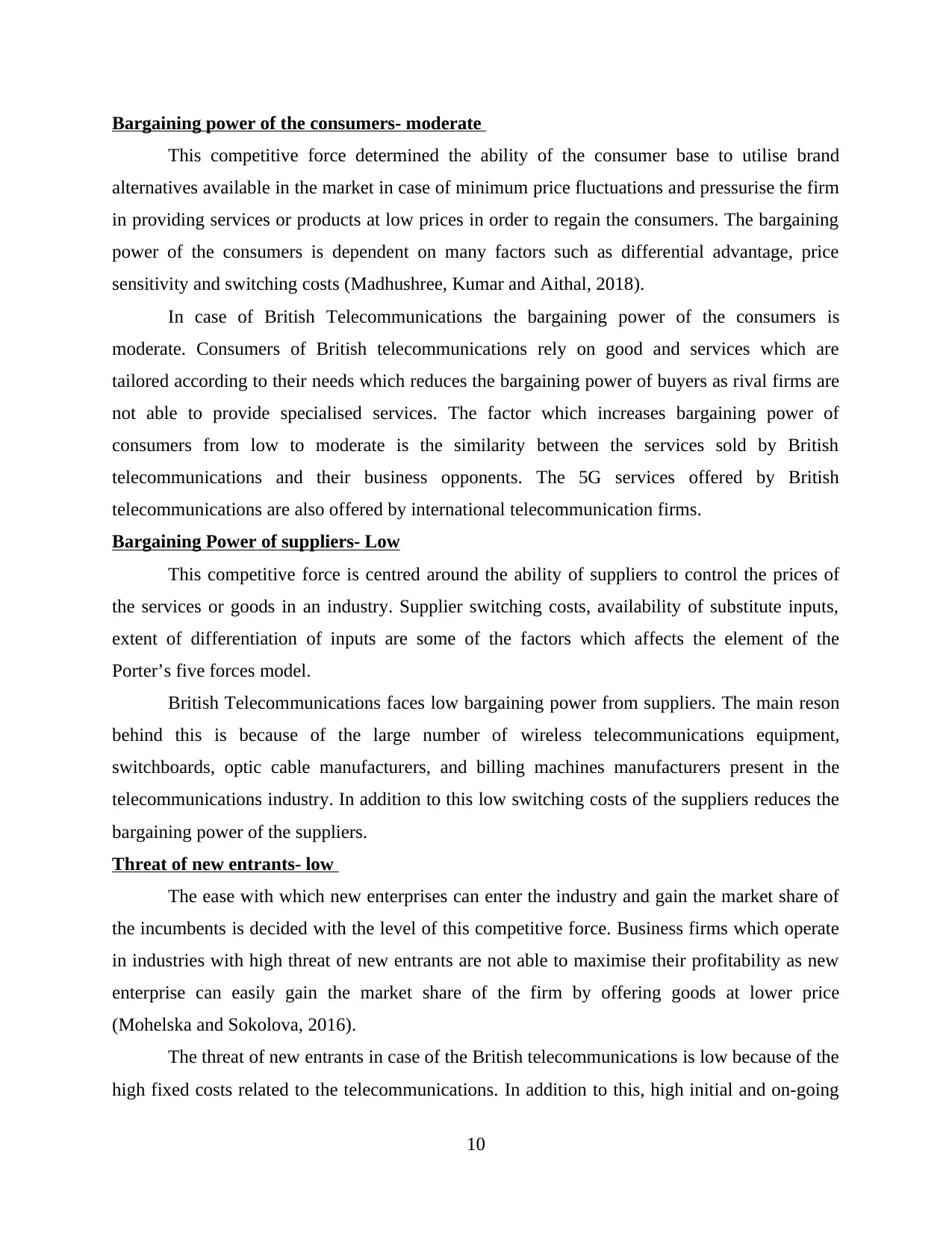
Bargaining power of the consumers- moderate
This competitive force determined the ability of the consumer base to utilise brand
alternatives available in the market in case of minimum price fluctuations and pressurise the firm
in providing services or products at low prices in order to regain the consumers. The bargaining
power of the consumers is dependent on many factors such as differential advantage, price
sensitivity and switching costs (Madhushree, Kumar and Aithal, 2018).
In case of British Telecommunications the bargaining power of the consumers is
moderate. Consumers of British telecommunications rely on good and services which are
tailored according to their needs which reduces the bargaining power of buyers as rival firms are
not able to provide specialised services. The factor which increases bargaining power of
consumers from low to moderate is the similarity between the services sold by British
telecommunications and their business opponents. The 5G services offered by British
telecommunications are also offered by international telecommunication firms.
Bargaining Power of suppliers- Low
This competitive force is centred around the ability of suppliers to control the prices of
the services or goods in an industry. Supplier switching costs, availability of substitute inputs,
extent of differentiation of inputs are some of the factors which affects the element of the
Porter’s five forces model.
British Telecommunications faces low bargaining power from suppliers. The main reson
behind this is because of the large number of wireless telecommunications equipment,
switchboards, optic cable manufacturers, and billing machines manufacturers present in the
telecommunications industry. In addition to this low switching costs of the suppliers reduces the
bargaining power of the suppliers.
Threat of new entrants- low
The ease with which new enterprises can enter the industry and gain the market share of
the incumbents is decided with the level of this competitive force. Business firms which operate
in industries with high threat of new entrants are not able to maximise their profitability as new
enterprise can easily gain the market share of the firm by offering goods at lower price
(Mohelska and Sokolova, 2016).
The threat of new entrants in case of the British telecommunications is low because of the
high fixed costs related to the telecommunications. In addition to this, high initial and on-going
10
This competitive force determined the ability of the consumer base to utilise brand
alternatives available in the market in case of minimum price fluctuations and pressurise the firm
in providing services or products at low prices in order to regain the consumers. The bargaining
power of the consumers is dependent on many factors such as differential advantage, price
sensitivity and switching costs (Madhushree, Kumar and Aithal, 2018).
In case of British Telecommunications the bargaining power of the consumers is
moderate. Consumers of British telecommunications rely on good and services which are
tailored according to their needs which reduces the bargaining power of buyers as rival firms are
not able to provide specialised services. The factor which increases bargaining power of
consumers from low to moderate is the similarity between the services sold by British
telecommunications and their business opponents. The 5G services offered by British
telecommunications are also offered by international telecommunication firms.
Bargaining Power of suppliers- Low
This competitive force is centred around the ability of suppliers to control the prices of
the services or goods in an industry. Supplier switching costs, availability of substitute inputs,
extent of differentiation of inputs are some of the factors which affects the element of the
Porter’s five forces model.
British Telecommunications faces low bargaining power from suppliers. The main reson
behind this is because of the large number of wireless telecommunications equipment,
switchboards, optic cable manufacturers, and billing machines manufacturers present in the
telecommunications industry. In addition to this low switching costs of the suppliers reduces the
bargaining power of the suppliers.
Threat of new entrants- low
The ease with which new enterprises can enter the industry and gain the market share of
the incumbents is decided with the level of this competitive force. Business firms which operate
in industries with high threat of new entrants are not able to maximise their profitability as new
enterprise can easily gain the market share of the firm by offering goods at lower price
(Mohelska and Sokolova, 2016).
The threat of new entrants in case of the British telecommunications is low because of the
high fixed costs related to the telecommunications. In addition to this, high initial and on-going
10
Paraphrase This Document
Need a fresh take? Get an instant paraphrase of this document with our AI Paraphraser
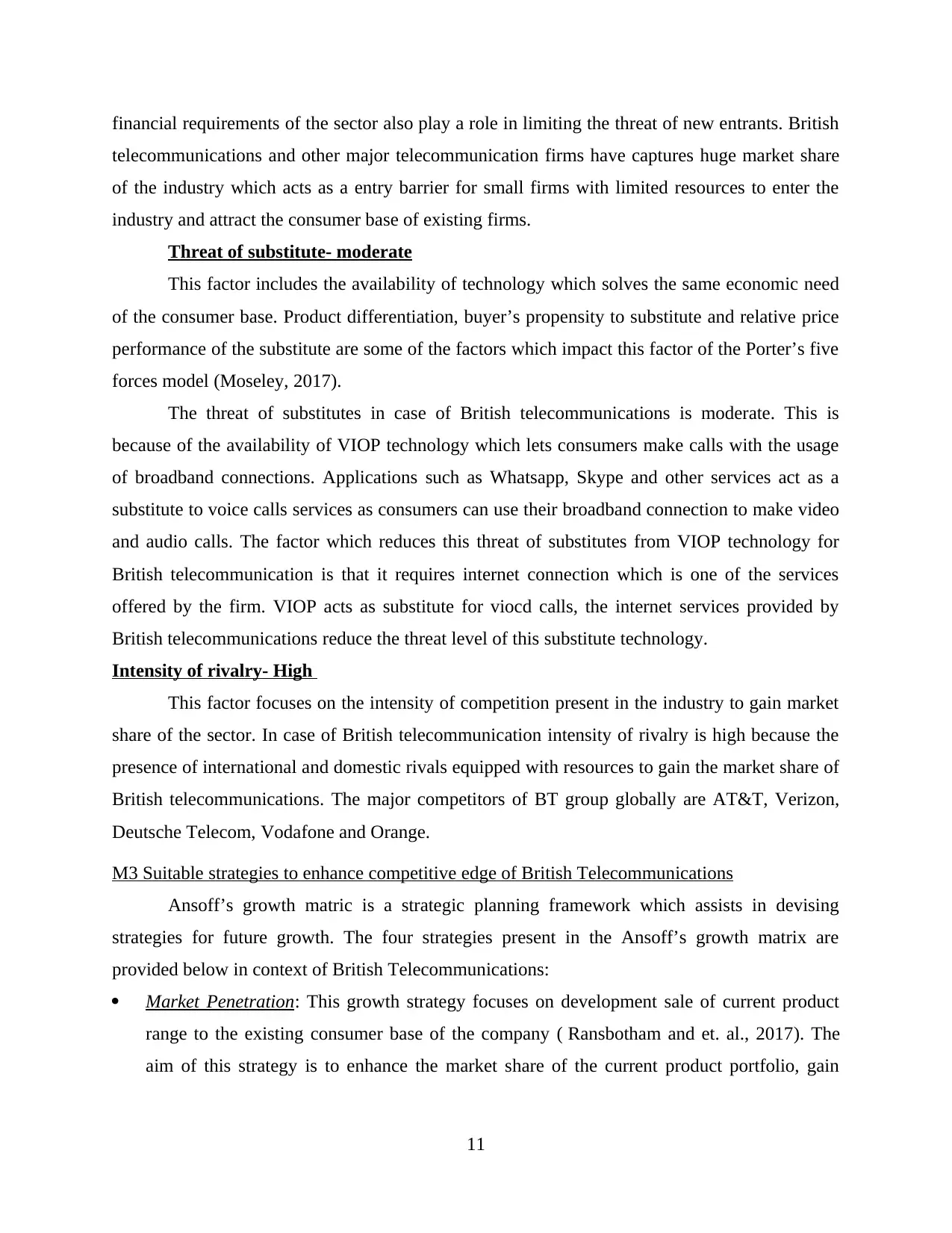
financial requirements of the sector also play a role in limiting the threat of new entrants. British
telecommunications and other major telecommunication firms have captures huge market share
of the industry which acts as a entry barrier for small firms with limited resources to enter the
industry and attract the consumer base of existing firms.
Threat of substitute- moderate
This factor includes the availability of technology which solves the same economic need
of the consumer base. Product differentiation, buyer’s propensity to substitute and relative price
performance of the substitute are some of the factors which impact this factor of the Porter’s five
forces model (Moseley, 2017).
The threat of substitutes in case of British telecommunications is moderate. This is
because of the availability of VIOP technology which lets consumers make calls with the usage
of broadband connections. Applications such as Whatsapp, Skype and other services act as a
substitute to voice calls services as consumers can use their broadband connection to make video
and audio calls. The factor which reduces this threat of substitutes from VIOP technology for
British telecommunication is that it requires internet connection which is one of the services
offered by the firm. VIOP acts as substitute for viocd calls, the internet services provided by
British telecommunications reduce the threat level of this substitute technology.
Intensity of rivalry- High
This factor focuses on the intensity of competition present in the industry to gain market
share of the sector. In case of British telecommunication intensity of rivalry is high because the
presence of international and domestic rivals equipped with resources to gain the market share of
British telecommunications. The major competitors of BT group globally are AT&T, Verizon,
Deutsche Telecom, Vodafone and Orange.
M3 Suitable strategies to enhance competitive edge of British Telecommunications
Ansoff’s growth matric is a strategic planning framework which assists in devising
strategies for future growth. The four strategies present in the Ansoff’s growth matrix are
provided below in context of British Telecommunications:
Market Penetration: This growth strategy focuses on development sale of current product
range to the existing consumer base of the company ( Ransbotham and et. al., 2017). The
aim of this strategy is to enhance the market share of the current product portfolio, gain
11
telecommunications and other major telecommunication firms have captures huge market share
of the industry which acts as a entry barrier for small firms with limited resources to enter the
industry and attract the consumer base of existing firms.
Threat of substitute- moderate
This factor includes the availability of technology which solves the same economic need
of the consumer base. Product differentiation, buyer’s propensity to substitute and relative price
performance of the substitute are some of the factors which impact this factor of the Porter’s five
forces model (Moseley, 2017).
The threat of substitutes in case of British telecommunications is moderate. This is
because of the availability of VIOP technology which lets consumers make calls with the usage
of broadband connections. Applications such as Whatsapp, Skype and other services act as a
substitute to voice calls services as consumers can use their broadband connection to make video
and audio calls. The factor which reduces this threat of substitutes from VIOP technology for
British telecommunication is that it requires internet connection which is one of the services
offered by the firm. VIOP acts as substitute for viocd calls, the internet services provided by
British telecommunications reduce the threat level of this substitute technology.
Intensity of rivalry- High
This factor focuses on the intensity of competition present in the industry to gain market
share of the sector. In case of British telecommunication intensity of rivalry is high because the
presence of international and domestic rivals equipped with resources to gain the market share of
British telecommunications. The major competitors of BT group globally are AT&T, Verizon,
Deutsche Telecom, Vodafone and Orange.
M3 Suitable strategies to enhance competitive edge of British Telecommunications
Ansoff’s growth matric is a strategic planning framework which assists in devising
strategies for future growth. The four strategies present in the Ansoff’s growth matrix are
provided below in context of British Telecommunications:
Market Penetration: This growth strategy focuses on development sale of current product
range to the existing consumer base of the company ( Ransbotham and et. al., 2017). The
aim of this strategy is to enhance the market share of the current product portfolio, gain
11

dominant position in existing market, increase product usage by current consumers and
make the market unsuitable for competitors.
British telecommunications can utilise this strategy by promoting affordable voice call services
to their consumers. In addition to this market penetration can also be attained by developing
loyalty scheme for the current consumer base.
Market Development: As per this growth strategy, business firms sell their current product
portfolio in an unexplored market. This includes entering new geographical location,
expanding distribution channels such as addition of online sales channels or building new
product dimensions such as packaging (Sanden, 2016).
In order to use this strategy, British telecommunications need to expand their international
presence in new markets which offer growth potential.
Product Development: This growth strategy involves introduction of new products for the
current consumer base of the company. Modifications in existing products or development
of new product line which is suitable for the current consumer base are required in order to
adopt this growth strategy.
Offering Internet of Things devices such as voice search assistants is a way off using this
strategy by British telecommunications to attain future growth because of the increasing usage
of smart devices.
Diversification: Entering new markets to introduce new products is the central concept of
diversification strategy. This strategy helps business firms grow as the product portfolio of
the enterprise is enhanced and the company is able to establish themselves in a new market.
The respective firm needs to develop VIOP services for new markets in order to apply this
strategy.
TASK 4
P5 Application of theories, concepts and models to develop strategic planning of a business firm
Porter’s generic strategies
Strategic options are provided by the porter’s generic strategies which helps business
devise strategic plan for the future of the company. The four strategies of this model are
described below in relation to British telecommunications:
Cost leadership strategy
12
make the market unsuitable for competitors.
British telecommunications can utilise this strategy by promoting affordable voice call services
to their consumers. In addition to this market penetration can also be attained by developing
loyalty scheme for the current consumer base.
Market Development: As per this growth strategy, business firms sell their current product
portfolio in an unexplored market. This includes entering new geographical location,
expanding distribution channels such as addition of online sales channels or building new
product dimensions such as packaging (Sanden, 2016).
In order to use this strategy, British telecommunications need to expand their international
presence in new markets which offer growth potential.
Product Development: This growth strategy involves introduction of new products for the
current consumer base of the company. Modifications in existing products or development
of new product line which is suitable for the current consumer base are required in order to
adopt this growth strategy.
Offering Internet of Things devices such as voice search assistants is a way off using this
strategy by British telecommunications to attain future growth because of the increasing usage
of smart devices.
Diversification: Entering new markets to introduce new products is the central concept of
diversification strategy. This strategy helps business firms grow as the product portfolio of
the enterprise is enhanced and the company is able to establish themselves in a new market.
The respective firm needs to develop VIOP services for new markets in order to apply this
strategy.
TASK 4
P5 Application of theories, concepts and models to develop strategic planning of a business firm
Porter’s generic strategies
Strategic options are provided by the porter’s generic strategies which helps business
devise strategic plan for the future of the company. The four strategies of this model are
described below in relation to British telecommunications:
Cost leadership strategy
12
⊘ This is a preview!⊘
Do you want full access?
Subscribe today to unlock all pages.

Trusted by 1+ million students worldwide
1 out of 17
Related Documents
Your All-in-One AI-Powered Toolkit for Academic Success.
+13062052269
info@desklib.com
Available 24*7 on WhatsApp / Email
![[object Object]](/_next/static/media/star-bottom.7253800d.svg)
Unlock your academic potential
Copyright © 2020–2025 A2Z Services. All Rights Reserved. Developed and managed by ZUCOL.




